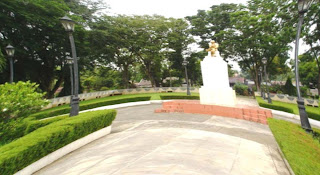Tik, Pak, Bong, Binuno, Inaswang and the Quest of Understanding Dystonia Panayensis
 |
| Balete's unique Rizal Monument after Rodin's The Thinker (Distorted in Photoshop) |
We used to hear it often said. Children sing-song among their peers: "Tik, pak, bong, binuno, inaswang!" And the children would scamper to find a safe place to hide as the "aswang" (the "it") hunts them down in the shadows of pasaw, lumboy and the bandstand. The game is called Bong, a variation of Paeanagu-an (Hide and Seek). The home base is an empty tin can that the players have to kick to save their ass from the "hungry witch" whose attention is diverted to retrieving the misplaced tin can.
But I missed playing it in my "brief" childhood. We were not allowed to stay late outside of our house. Orasyon, aside from being a moment of prayer, was meant to mark the start of our curfew. Tatay never explained why and we dared not question his policy. Perhaps, he was afraid of the aswang prowling in the dark. Old people believe in its existence. Even a friend who came home from abroad believes its existence as she avers that she saw the transformation of an animagus into a huge albino German shepherd-like dog scouting her. I pray she won't start off bathing her daughter with an orasyon, "Pwera sigbin, pwera aswang."
In my neighborhood (Aranas) in the 70's, there live a family whose members were said to have been victim of black magic. The victims were mostly boys who at a certain age would show off signs of the malaise. Inaswang kuno. Ginpaamulitan, hambae man ko iba. (They claimed that they are victims of witchcraft). But my mother* did not believe. She felt it that it was her duty to advise the family to see a neurologist (Aklan had none and Roxas was the most proximate place to see one). She did also report the matter to proper authority. She sent out fillers to experts, giving them clue of the symptoms of body distortions (naga-eubag) and the doctors of Roxas City referred the complicated case to Manila prompting a couple of neurologists** to visit the family. The visit in turn became periodic as the experts noted that the patients were suffering from a very rare genetic disorder: sex linked recessive dystonia--dystonia panayensis***, my mother told me. She described it as something unique of Panay Island and that it predominantly affects adult male.
We no longer hear the children chorus the sing-song, "Tik, pak, bong, binuno, inaswang" today. They are too busy playing the computers or watching TVs at nighttime that they never bother learning the art of playing Bong in the plaza. They get the feel of the thrill in playing Plants vs. Zombies instead of scampering behind the bush of pasaw. Yet they still believe in aswang and the experts are still without treatment to offer in dealing with the unique genetic disorder affecting the men of Panay.
_____________
*My mother was midwife of Balete from 1971 to 1992. She was promoted as the Supervising Midwife and was assigned at the Integrated Provincial Health Office after Balete. Around 1991, she was designated as the Provincial Coordinator on Dystonia Parkinsonism and was collaborating closely with Dr. Lilian V. Lee's aide, Dr. Rivera (I can't recall her first name)
**First Filipina honors Dr. Lilian V. Lee as the one who discovered the causes of the brain disorder called Recessive Dystonia Parkinsonism
***The Journal of Clinical Pathology has an interesting article about Sex-linked Recessive Dystonia Parkinsonism of Panay at this link:
http://www.ncbi.nlm.nih.gov/pmc/articles/PMC1187125/
Other reviews are at:
http://www.ncbi.nlm.nih.gov/pubmed/2030641,
http://www.ncbi.nlm.nih.gov/pubmed/12217620 (On Natural History of XDP)
http://www.ncbi.nlm.nih.gov/pubmed/1672807 (On Genetic Mapping of "Lubag") in a Filipino Kindred
http://www.ncbi.nlm.nih.gov/pubmed/11724910 (On Sex-Linked XDP)


Comments
Post a Comment